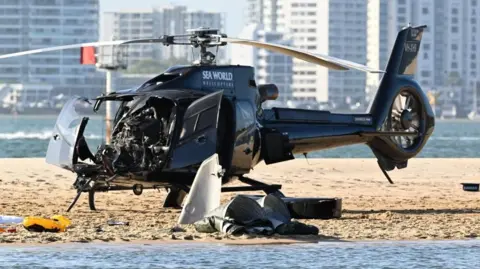Faulty antenna played role in fatal Australian helicopter crash
 EPA
EPAA faulty radio antenna contributed to a deadly mid-air helicopter collision at an Australian theme park and resort, transport safety officials say.
Four people died - including two British tourists - and several more were seriously injured when the two aircraft hit each other in January 2023, near Sea World on the Gold Coast.
An investigation by Australia's Transport and Safety Bureau (ATSB) found one of the pilots did not hear a vital radio call shortly before the accident, and that a series of changes by Sea World meant risk controls were over time eroded.
The accident rocked the Gold Coast, one of the nation's biggest tourist hotspots.
The two helicopters collided around 20 seconds after one had taken off and as the other was landing.
Those who died were all travelling in the helicopter which was taking off. The other aircraft managed to make an emergency landing, with passengers suffering a range of injuries.
The ATSB report found that in the months leading up to the accident, Sea World had tried to improve its offering of leisure flights by adding a second helipad location and introducing larger Eurocopter EC140 B4 helicopters.
"Over time, these changes undermined risk controls used to manage traffic separation and created a conflict point between... helicopters," it said.
The aircraft preparing to take off also had a faulty antenna.
In the run-up to the collision, a call from the arriving helicopter was either not received or not heard by the pilot on the ground, who was loading passengers at the time.
However, once the passengers were on board, a ground crew member advised the departing helicopter pilot that the airspace was clear. By the time the chopper took off, though, that information was no longer correct.
Meanwhile the pilot who was wanting to land after a five-minute scenic flight had seen the other helicopter on the ground but didn't deem it a threat, the report said.
He would have expected to have been alerted by a "taxiing" radio call if that situation changed. However the faulty antenna likely prevented the broadcast of the taxiing call, the report said.
"Without the taxiing call being received, the pilot of the inbound helicopter, who was likely focusing on their landing site, had no trigger to reassess the status of the departing helicopter as a collision risk."
Among those who died were Diane Hughes, 57, and her 65-year-old husband Ron who were from Neston, Cheshire. They had married in 2022 and were on holiday visiting relatives after being separated by COVID.
The "fun-loving" couple from Neston, Cheshire, had "a zest for life", their family said in a statement at the time.
Also killed was Sydney resident Vanessa Tadros, 36, and 40-year-old Sea World Helicopters pilot Ashley Jenkinson, who was originally from Birmingham.
A further six people were seriously injured while three others sustained minor injuries in the crash.
Shortly after the accident, the passengers on the flight that was returning hailed the pilot as a "hero" for landing the helicopter safely.
In all, the Australian Transport Safety Bureau made 28 findings that underline "key lessons" for operators and pilots.
"The most fundamental lesson from this investigation is that making changes to aviation operations, even those that appear to increase safety, can have unintended consequences," ATSB Chief Commissioner Angus Mitchell said.
"It is therefore critical that changes to aviation operations are managed through the implementation of a defined process to ensure overall safety is not adversely affected."
